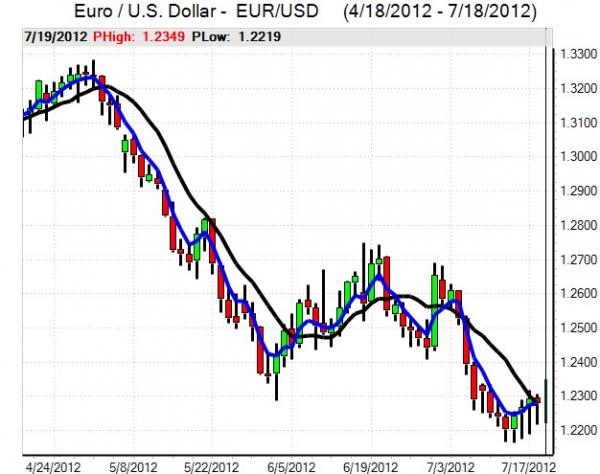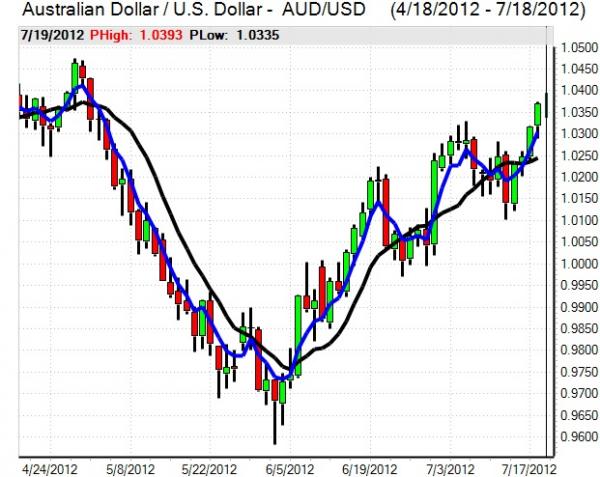EUR/USD
The Euro was blocked in the 1.23 region against the dollar on Wednesday and dipped lower during the European session, although it held above technical support levels and the lows seen during Tuesday. There were some rumours of an Austrian credit-rating downgrade and comments from German Chancellor Merkel were construed in a negative light, although there was little in the way of substantive comments. There was also caution ahead of the German Bundestag vote on Spain’s banking-sector bailout due on Thursday.
Yield trends remained very important within the Euro-zone and global markets. There was a negative yield at the latest German 2-year bond auction for the first time on record and market yields remained below zero in six countries as there was further evidence of capital flows away from peripheral economies. The Bank of Spain reported a further drop in bank deposits for June and the bad loan ratio within the banking sector increased to near 9.0% according to the latest data.
There was a 6.9% increase in US housing starts to an annual rate of 760,000 which was offset by a dip in permits for the month. There was a slight downgrading of growth prospects in the latest Fed Beige Book which reinforced expectations of a significant slowdown, although the overall impact was limited. Fed Chairman Bernanke’s comments surrounding the US outlook were broadly in line with the previous day, maintaining expectations that further easing could be sanctioned
He did state that Europe was close to a long-term solution which will tend to reinforce global growth fears and these concerns were echoed within the IMF’s latest report as it saw severe downside risks surrounding the Euro-zone outlook. The IMF called for a further cut in ECB interest rates and for quantitative easing which will tend to undermine the Euro. The Euro consolidated above the 1.2250 level in generally subdued conditions with a push towards 1.2300.

Source: VantagePoint Intermarket Analysis Software
Call now and you will be provided with FREE recent forecasts
that are up to 86% accurate* 800-732-5407
If you would rather have the recent forecasts sent to you, please go here
Yen
The dollar initially found support in the 78.90 area and briefly spiked back above the 79 level. There were reports that the Japanese Finance Ministry was considering a more aggressive intervention policy if the yen strengthens significantly from current levels and this triggered immediate selling pressure.
The dollar was unable to sustain the gains and retreated to the 78.80 area with the yen gaining defensive support on global growth concerns, especially with the dollar struggling to find yield support. This trend continued in Asian trading on Thursday with the dollar retreating to lows just below 78.50 despite gains in regional equity markets which suggests underlying yen demand with a lack of confidence in major alternatives.
Sterling
Sterling hit resistance above 1.5650 against the dollar on Wednesday and dipped to test support just below the 1.56 level.
The latest unemployment claimant count data was close to expectations with a 6,100 increase in the total for June following a 6,900 increase the previous month. The ILO data was more favourable as the unemployment rate dipped to 8.1% from 8.2% which provided some relief.
The Bank of England recorded a 9-0 vote for unchanged interest rates while there was a 7-2 vote for the additional GBP50bn quantitative easing. All members agreed that further stimulus was warranted and there was discussion of an additional GBP75bn. The sanctioning of the new lending programme discouraged the more aggressive stance at this stage and two members voted for no change. Nevertheless, the underlying tone was one of major concern surrounding the economic outlook.
There was further evidence of defensive flows into UK bonds with benchmark yields close to record lows and Euro-zone fears could continue to trigger near-term Sterling support despite the domestic doubts.
Swiss franc
The dollar found support on dips towards the 0.9770 region against the franc on Wednesday while it was unable to challenge resistance in the 0.9850 region. The Euro remained trapped close to the 1.2010 region during the day.
The latest Swiss ZEW survey was little changed at -42.5 for July which will maintain a lack of confidence in the economic outlook and pressure for franc gains to be resisted. The Economics Ministry reaffirmed its commitment to the 1.20 minimum level, but there will be increasing pressure on the National Bank if conditions deteriorate further and defensive capital inflows intensify.

Source: VantagePoint Intermarket Analysis Software
Call now and you will be provided with FREE recent forecasts
that are up to 86% accurate* 800-732-5407
If you would rather have the recent forecasts sent to you, please go here
Australian dollar
The Australian dollar found support just below the 1.03 level against the US currency on Wednesday and pushed higher during the US session as equity markets attempted to rally.
There was solid demand for the Australian currency as it pushed to a two-month high above the 1.0350 level with further gains to a peak near 1.04 in Asia on Thursday. There was a decline in business confidence according to the latest quarterly NAB survey which did not have a major impact with the Australian currency pushing to fresh record highs against the Euro.



